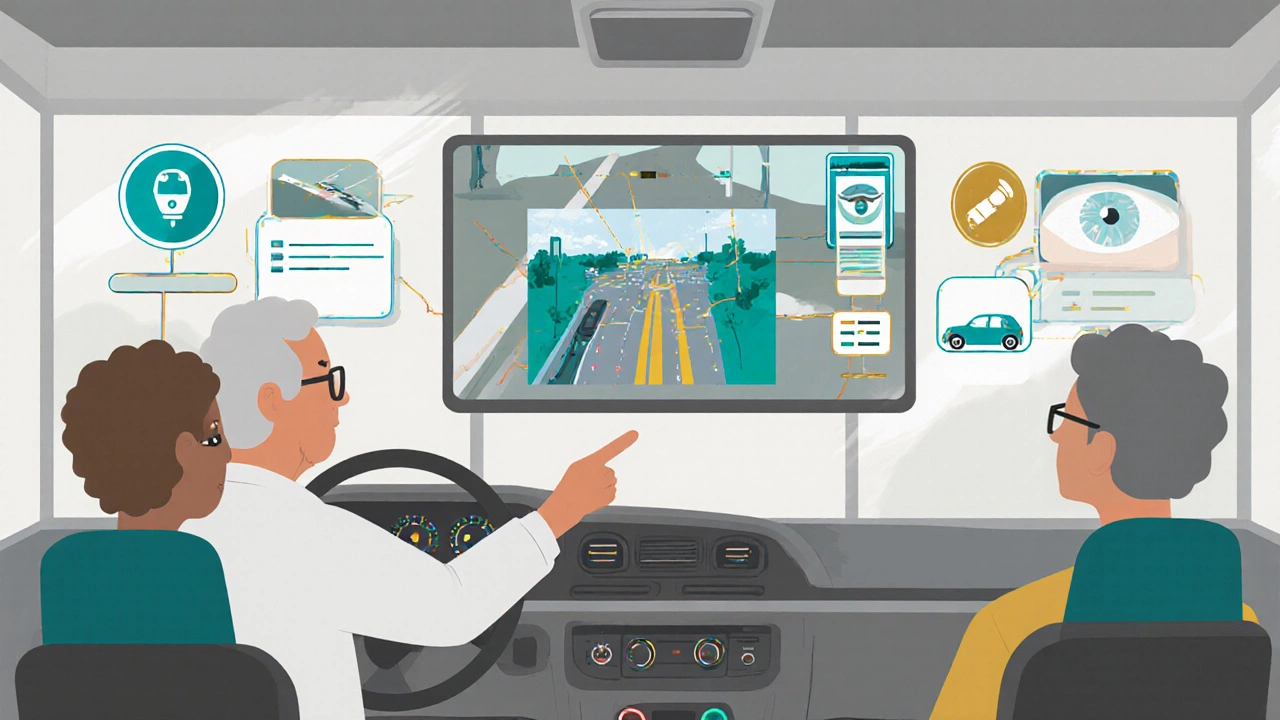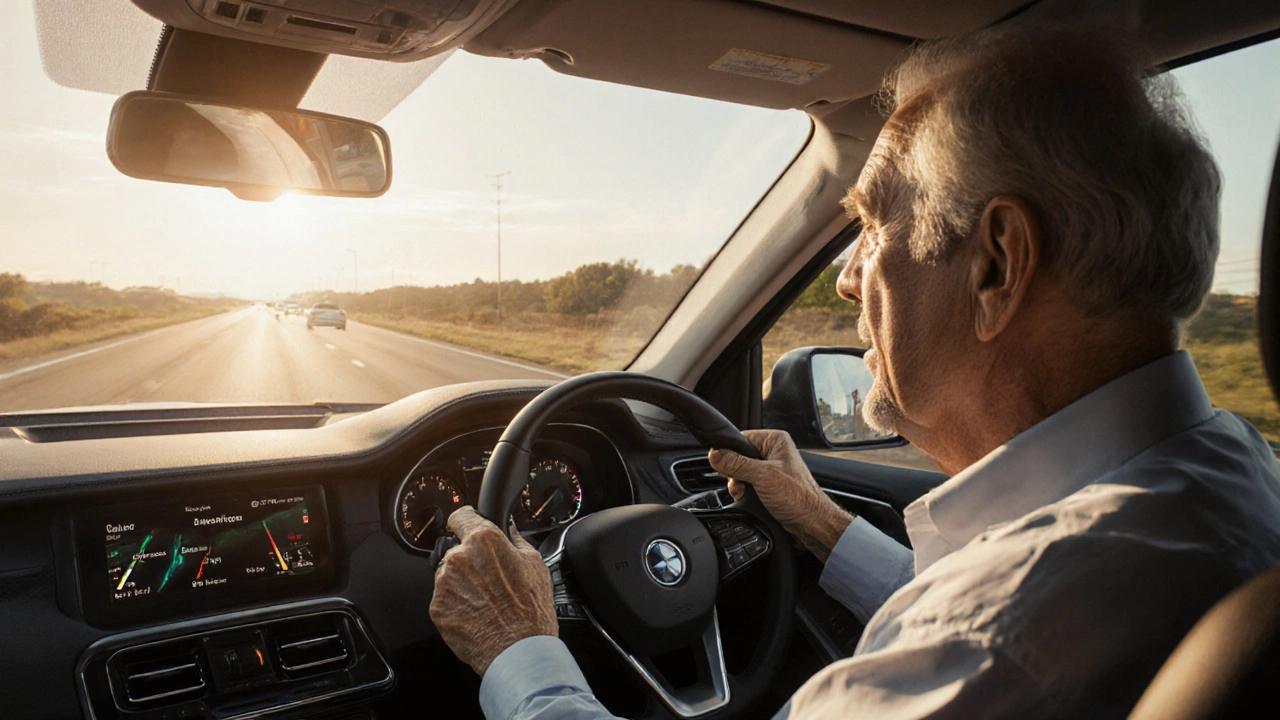Driving Safety Assessment Tool
This tool helps you assess your driving safety based on age-related changes. Answer these questions to get personalized recommendations.
Vision Changes
Reaction Time
Medication Effects
Technology Use
Recent Changes
Many people assume driving gets harder as you age-but it’s not about the number on your birthday. It’s about how your body and mind change, and whether you’ve adjusted your driving habits to match. If you’re wondering if 55, 65, or 70 is when driving becomes too tough, the truth isn’t simple. Some drivers stay sharp into their 80s. Others struggle by 60. The difference? Awareness, adaptation, and practice.
It’s Not Age, It’s Change
Driving doesn’t suddenly become impossible at a certain age. But around 50 to 60, subtle changes start adding up. Your eyes don’t adjust to glare as quickly. You need more light to read road signs. Reaction times slow by 10 to 20% compared to your 30s. Hearing high-pitched sounds-like a horn or a siren-becomes harder. These aren’t dramatic failures. They’re quiet shifts that sneak up on you.
A 2023 study by the New Zealand Transport Agency found that drivers over 65 were more likely to be involved in crashes at intersections-not because they were reckless, but because they took longer to process multiple visual cues. That’s not a moral failing. It’s biology. And it’s fixable.
Why Intensive Driving Courses Help After 50
If you’ve been driving for 40 years, you might think you know everything. But driving today is different. Traffic is heavier. Road signs are more complex. Cars have more tech-blind-spot warnings, automatic braking, lane-keeping assist. Many older drivers don’t know how to use these features, or worse, they ignore them because they think they don’t need them.
An intensive driving course for older drivers isn’t about relearning how to steer. It’s about relearning how to see, think, and react. These courses focus on:
- Adapting to modern vehicle technology
- Managing glare and night driving
- Improving scanning techniques at intersections
- Understanding how medications affect reaction time
- Building confidence after a minor incident or near-miss
One participant, a 68-year-old from Christchurch, took a five-day intensive course after nearly hitting a cyclist while turning left. He thought he was fine. The instructor showed him footage of his head movement-his gaze rarely checked the left blind spot. After two days of targeted drills, he could scan smoothly and confidently. He didn’t need to stop driving. He just needed to update his habits.
Signs Driving Is Becoming Harder
You don’t need to wait for a crash to realize it’s time to adjust. Watch for these early signals:
- You avoid driving at night or in rain because it feels unsafe
- You’ve started taking longer routes to avoid busy intersections or highways
- You get confused by new road signs or roundabouts
- You feel anxious or overwhelmed in heavy traffic
- You’ve had near-misses or small bumps you can’t explain
- Friends or family mention you seem less confident behind the wheel
These aren’t signs you should stop driving. They’re signs you should refresh your skills. Many people wait until they’re told to surrender their licence. That’s too late. The best time to act is when you notice the first hint of discomfort.

Medications and Driving
One of the biggest hidden risks for drivers over 60 is medication. It’s not just about being drowsy. Many common prescriptions-like those for high blood pressure, arthritis, or sleep-interfere with coordination, focus, or reaction time. A 2024 review in the Journal of Transport Medicine found that 37% of drivers over 65 were taking at least one drug that affected driving ability, and nearly half didn’t realize it.
Always check with your doctor or pharmacist: “Could this affect my driving?” Don’t assume it’s safe because it’s prescribed. If a drug causes dizziness, blurred vision, or fatigue, adjust your driving habits. Drive only during daylight. Avoid rush hour. Skip long trips.
Technology Can Help-If You Let It
Modern cars are packed with safety tools designed to compensate for aging. But most older drivers don’t use them-or turn them off because they think they’re annoying.
Here’s what actually works:
- Blind-spot monitoring: Helps you see cars you can’t turn your head to check
- Automatic emergency braking: Slows or stops the car if you don’t react in time
- Adaptive cruise control: Reduces stress on highways by managing speed automatically
- Reverse parking assist: Takes the guesswork out of backing up
Don’t treat these like gadgets. Treat them like seatbelts. They’re not there to replace your skill-they’re there to support it. If your car has these features, learn how to use them. An intensive course can show you how.
When to Consider Stopping
No one wants to give up driving. It’s freedom. Independence. But sometimes, safety comes before pride.
Here are clear reasons to consider stopping:
- You’ve had three or more minor crashes or near-misses in two years
- You get lost on familiar roads
- You’ve been told by a doctor to stop driving
- Your vision or reaction time has declined beyond what corrective lenses or training can fix
Stopping doesn’t mean losing your life. It means finding new ways to get around. Many towns now offer subsidized rides for seniors. Ride-share apps are easier than ever. Family members can help with errands. You don’t have to drive to stay connected.
What to Do Next
If you’re over 50 and wondering if driving is getting too hard, don’t wait for a crisis. Take action now:
- Book a free vision and hearing check with your GP
- Ask your doctor about any medications you’re taking
- Try an intensive driving course designed for older adults-many are under $200 and last just 3 to 5 days
- Test your car’s safety tech. Learn how to turn it on and use it
- Talk to someone you trust about how you feel behind the wheel
Driving doesn’t have to get harder as you age. It just needs to change. The right support, the right training, and the right mindset make all the difference.
Is 60 too old to start an intensive driving course?
No. Many people in their 60s and even 70s take intensive courses to refresh their skills. These courses aren’t for beginners-they’re for experienced drivers who want to adapt to changes in vision, reaction time, and modern car tech. In fact, older drivers often learn faster because they’re motivated and focused.
Do I need to retake my driving test if I’m over 65?
In New Zealand, you don’t need to retake your driving test at any age. But from age 75, you must renew your licence every three years and declare your fitness to drive. Some drivers choose to take a voluntary assessment through a driving school to stay confident. It’s not required, but it’s smart.
Can I still drive if I have arthritis?
Yes, if you manage it. Arthritis can make turning the wheel or pressing pedals uncomfortable, but many drivers adapt with hand controls, padded grips, or seat adjustments. An intensive course can help you find the right setup. If pain limits your ability to steer or brake safely, talk to your doctor. There are solutions before you give up driving.
Are older drivers more dangerous than young drivers?
No. Young drivers (16-24) have far higher crash rates per kilometre driven. Older drivers (75+) are more likely to be injured in crashes because their bodies are more fragile, but they’re not the main cause of accidents. Most crashes involving older drivers happen at intersections due to slower reaction times-not recklessness. The real issue is lack of adaptation, not age.
What’s the best way to stay safe if I’m driving past 70?
Stick to familiar routes. Avoid rush hour and bad weather. Drive during daylight. Use your car’s safety features. Take a refresher course every two years. Get your eyes checked annually. And never ignore that gut feeling-if something feels off, pull over. Your safety isn’t about how long you’ve driven. It’s about how well you’re driving now.
Final Thought
Driving isn’t about how young you were when you started. It’s about how present you are behind the wheel today. Age brings changes-but it also brings wisdom. Use that wisdom to adapt. You don’t have to give up driving. You just have to keep learning.

